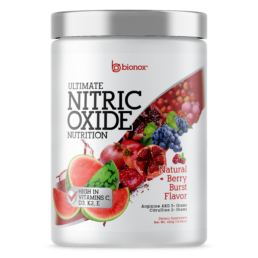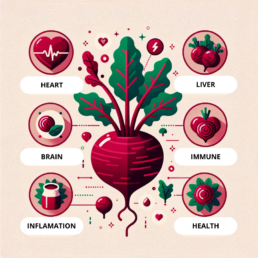What are the benefits of taking beetroot supplements?
What are the benefits of taking beetroot supplements?
Welcome to the vibrant, red, purple, and somewhat underrated world of beetroot, a true nutritional powerhouse that’s more than just a splash of color on your plate or in your juicer.
Beetroot, or as some like to call it, nature’s powerhouse, is packed with an array of vitamins and minerals; it literally contains a treasure trove of health benefits built-in vegetable form.
Now, let’s dive a bit deeper, shall we? We’re not just talking about beetroot in its raw or cooked state; nope, we’re venturing into the realm of beetroot supplements – a concept catching on for its convenience and concentrated goodness. Raw, potent, and loaded with heart-healthy nutrients, beetroot supplements are taking off; let’s discover why!
What are the benefits of taking beetroot supplements for improved cardiovascular health?
Beetroot supplements have garnered significant attention recently and in the past for their cardiovascular benefits.
The secret lies in their high nitrate content, which the body converts into nitric oxide. This compound plays a crucial role in regulating blood vessel dilation, thereby enhancing blood flow and reducing the strain on the heart to name just a few of it’s important functions.
Beetroot Studies
Studies have shown that the regular intake of beetroot supplements can lead to improved heart health. For instance, research published in the Journal of Nutrition demonstrated that beetroot supplementation resulted in lower blood pressure and arterial stiffness, two key factors in maintaining and keeping cardiovascular health. Additionally, the beetroot’s antioxidant properties help reduce oxidative stress, which is a major contributor to heart disease.
Benefits Of Beetroot
The benefits of taking beetroot supplements regularly extend to the reduction of bad cholesterol levels while simultaneously increasing good cholesterol. This balance is vital for preventing plaque buildup in arteries, a leading cause of heart attacks, strokes, and death, especially in the West.
Folate In Beetroot
Furthermore, the presence of compounds like betaine and folate in beetroot aids in reducing homocysteine levels, high levels of which are associated with an increased risk of cardiovascular diseases.
What are the benefits of taking beetroot supplements for enhanced athletic performance?
Beetroot supplements have become a popular ergogenic aid among athletes, ergogenic meanins ( helps with sports) .
The nitrates in beetroot are converted into nitric oxide, which enhances blood flow to muscles, improving oxygen and nutrient delivery and enhancing sports performance.
Boosting Sports Performance
This process is particularly beneficial during high-intensity workouts or endurance sports, where efficient oxygen utilization is critical for performance. A study in the Journal of Applied Physiology found that athletes who consumed beetroot supplements before exercising experienced significant performance improvements and delayed fatigue.
The benefits of beetroot supplements in athletic and sports performance also include faster recovery times.
Beetroot Is Anti-inflammatory
Beetroot’s anti-inflammatory and antioxidant properties help reduce muscle soreness and aid in quicker recovery post-exercise. Athletes consuming beetroot supplements have reported feeling less muscle pain and faster return to peak performance levels after strenuous workouts. The improved blood flow also contributes to better thermoregulation during exercise, allowing athletes to maintain optimal body temperature and performance.
What are the benefits of taking beetroot supplements for blood pressure regulation?
The regulation of blood pressure is another key benefit of beetroot supplements, but as a caveat, only the highest quality ones really work well; more on that later.
High blood pressure, or hypertension, is a common health concern that can lead to severe health complications if left unmanaged. The nitrates in beetroot are effective in dilating blood vessels or opening them, which helps lower blood pressure.
Blood Pressure
A meta-analysis in the Journal of Nutrition highlighted the significant impact of beetroot juice supplementation in reducing systolic and diastolic blood pressure.
The impact of beetroot supplements on blood pressure is particularly beneficial for individuals with hypertension or those at risk of developing cardiovascular diseases. By improving endothelial function, which is the ability of blood vessels to dilate, beetroot supplements contribute to overall cardiovascular health. Moreover, the potassium content in beetroot also plays a role in blood pressure regulation by balancing out the negative effects of sodium.
Cardiovascular Health
The mainstream benefits of beetroot supplements encompass improved cardiovascular health, enhanced athletic performance, and effective blood pressure regulation. These benefits stem from the high nitrate content of beetroot, which the body converts into nitric oxide, improving blood flow and oxygen delivery and supercharging the heart. The antioxidant and anti-inflammatory properties further contribute to heart health and recovery post-exercise.
As a natural supplement, beetroot offers a convenient and effective way to enhance overall health and well-being.
Exploring the Lesser-Known Benefits of Beetroot Supplements
Beetroot is known for its deep crimson color and earthy flavor. It’s often consumed for its taste and nutritional value, but what’s less known are the remarkable health benefits of beetroot supplements, especially relating to cognitive health, anti-inflammatory effects, and liver health.
Cognitive Health: Improving Brain Function and Reducing the Risk of Dementia
- Mechanism of Action
- Beetroot is rich in nitrates, which the body converts into nitric oxide. Nitric oxide is crucial for maintaining vascular health; this includes the super-important cerebral arteries.
- Improved blood flow to the brain enhances oxygen and nutrient delivery, which is essential for optimal brain function. An oxygen-rich brain is a healthy brain.
- Research Findings
- Studies have shown that beetroot supplementation can enhance cognitive function, particularly in older adults. This may make it a very useful friend of elderly adults.
- A study published in the “Journal of Gerontology” found that dietary nitrate, like that which is derived from common beetroot, improved the blood flow to the frontal lobes of the brain, an area often associated with cognitive decline as we age.
- Potential in Dementia Prevention
- Regular intake of beetroot supplements may reduce the risk of dementia by maintaining healthy blood vessels in the brain.
- Beetroot supplements offer neuroprotective benefits by reducing oxidative stress and inflammation, which are key contributors to cognitive decline.
Anti-Inflammatory Effects: How Beetroot Combats Inflammation
- Bioactive Compounds
- Beetroot contains various anti-inflammatory compounds like betalains, which give it its red color that we all know and love. These fantastic compounds have been shown to inhibit specific signaling pathways that lead to inflammation.
- It also contains a good amount of folate and magnesium, known for their anti-inflammatory properties.
- Clinical Evidence
- Research indicates that beetroot can significantly reduce markers of inflammation. A study in the “Journal of Inflammation” noted that beetroot supplementation reduced C-reactive protein levels, a marker for inflammation, in participants.
- Applications in Chronic Conditions
- Chronic inflammation is a root cause of many diseases, including heart disease, arthritis, and certain cancers. Regular consumption of beetroot supplements can play a role in managing and preventing these conditions.
Impact on Liver Health: Detoxification and Liver Function Support
- Detoxification Properties
- The liver is crucial for detoxification in the body, and this particular aspect of beetroot is often ignored. Beetroot contains compounds that stimulate the liver’s detoxifying enzymes.
- Glutathione, a key detoxifying agent, is increased by the consumption of beetroot, aiding in eliminating toxins.
- Supporting Liver Function
- Beetroot is high in antioxidants, which protect liver cells from oxidative stress and damage.
- Studies suggest that the regular intake of beetroot can help in the treatment of liver diseases, including fatty liver disease.
- Enhancing Liver Health
- The dietary fiber in beetroot aids in digestion and helps in maintaining liver health by preventing fatty deposits.
- Beetroot also helps in balancing internal pH and stimulating bile production, which further aids liver function.
Clear Health Benefits
Beetroot supplements offer an array of lesser-known but significant health benefits, especially in enhancing cognitive function, combating inflammation, and supporting liver health. While it is widely recognized for its ability to improve athletic performance and cardiovascular health, these additional benefits make it an invaluable addition to a health-conscious individual’s diet.
The cognitive benefits, in particular, are promising, offering potential in the fight against age-related cognitive decline and dementia. Its anti-inflammatory properties make it a natural and effective option for managing chronic inflammation and associated diseases. Moreover, its impact on liver health, a crucial organ for detoxification and metabolism, is an area of increasing interest.
If you would like to know more, join our newsletter!
The Horse Chestnut For Heart Health: A Historical and Therapeutic Overview
Introduction
The horse chestnut, an important ingredient in many heart and circulation support formulas today. It is commonly used for promoting heart health. Its scientific name is Aesculus hippocastanum and is so much more than just the big tree you may have seen in a park. This article delves into the fascinating journey of the horse chestnut. We will be tracing its roots from historical significance to its role in today’s health practices. Our focus will be particularly in the realm of heart support.
The horse chestnut is known for its distinctive spiny fruits and brown seeds. They are often playfully referred to as “conkers”. The horse chestnut is significant in various cultures and traditional practices. Its story is rich with folklore, medicinal applications, and a longstanding presence in human history.
Ancient Remedies
We will explore how these historical uses have turned into modern medicinal applications. Also, we will be shedding light on this remarkable tree’s enduring relevance. Our aim will be helping you understand when and how to use it and explain its heart supporting role.
From ancient remedies and cures to current scientific research it has a long history of use. The horse chestnut’s journey is a testament to the interplay between nature and human health. This introduction sets the stage for a comprehensive exploration of the horse chestnut’s popular use. Its promising future in supporting heart health is also of interest.

Origins and Taxonomy
The horse chestnut, known scientifically as Aesculus hippocastanum, is a tree that has captivated attention both for its beauty and its medicinal properties. In this section, we delve into its scientific classification and origins. We will be tracing the journey of this remarkable tree from then old times to present. Horse Chestnut has widespread distribution across various landscapes worldwide. Here is a little more about it:
Scientific Classification
- Kingdom: Plantae – Denoting its status as a plant.
- Clade: Angiosperms and Eudicots – Indicating it’s a flowering plant with a specific seed structure.
- Order: Sapindales – A group known for species like maples and lychee.
- Family: Sapindaceae – A family that includes a variety of flowering plants.
- Genus: Aesculus – This genus comprises all horse chestnut species.
- Species: A. hippocastanum – The specific scientific name for the horse chestnut.
Origins
The horse chestnut likely originated from the Balkan Peninsula in Southeast Europe. It was not native to the British Isles but arrived there in the late 16th century. After its introduction, it quickly gained popularity worldwide for its ornamental value and natural beauty.
Geographic Distribution and Natural Habitat
The horse chestnut first appeared in the mountainous regions of Greece and Albania. It has since been widely cultivated across Europe and other parts of the world. Its ability to adapt to different soil types and climates has led to its widespread cultivation and use. Today, you can find it in temperate regions of Europe, North America, and parts of Asia.
In its natural habitat, the horse chestnut prefers moist, fertile soils. It commonly populates parklands and large gardens. It thrives in full sun but also tolerates semi-shaded areas. This makes it a highly adaptable species for various landscapes and locations.
This tree’s journey from the mountainous regions of the Balkans to its present-day global presence is a story of botanical migration. It is also one of human appreciation for its aesthetic and practical value. The horse chestnut’s adaptability not only to different terrains but also to cultural uses is significance. It underscores its role as a botanical traveler and a cherished component of the natural world.
Historical Uses and Cultural Significance
The horse chestnut tree has a rich tapestry of uses and significance woven through its rich history. This section explores its traditional roles in folk medicine, its cultural impact across different regions, and how its usage has evolved over time.
Traditional Uses in Folk Medicine and Early Medicine
Early Medicinal Applications
People traditionally used various parts of the horse chestnut tree, especially the seeds, leaves, and bark, in folk remedies across different regions. Practitioners highly valued the seeds for their effectiveness in treating varicose veins and hemorrhoids. Folk practitioners also turned to horse chestnut for its anti-inflammatory properties to reduce pain and swelling. This makes it a popular ingredient in many excellent nitric oxide products, as inflammation in the arteries can harm your heart. In some cultures, people used the tree’s components to address respiratory issues and fever. This is important since pulmonary and heart health are closely linked.
Cultural Significance in Different Regions
Europe: In its native Balkans and across Europe, the horse chestnut symbolizes strength and endurance. Its blossoming signaled the arrival of spring and featured prominently in local folklore.
British Isles: After its introduction, it became a staple in British gardens and parks, with ‘conkers’ becoming a cultural staple among children.
North America: Introduced later in North America, the tree is appreciated for its ornamental value, adding aesthetic beauty to parks and streets, just as in Europe.
Evolution in Usage Over Time
- From Folk Remedy to Scientific Study: The transition of horse chestnut from a folk remedy to a subject of scientific research marks a significant evolution. Modern medicine has taken interest in its active compound, aescin, for its potential therapeutic benefits.
- Contemporary Herbal Medicine: Today, horse chestnut extracts are widely used in herbal medicine, especially in Europe, for treating circulatory problems. They are increasing in use in the US as well, and form an important part of many heart health products.
- Changing Perceptions: The perception of the horse chestnut has shifted from a common tree to a valuable medicinal resource, with ongoing research exploring new therapeutic applications and tons of products, including its use today.
This historical journey of the horse chestnut, from traditional folk medicine to contemporary medicinal applications for blood pressure and heart support, highlights its therapeutic potential and cultural resonance across different European societies. China on the other hand merrits its own section and we will discuss that below.

The Use of Horse Chestnut in Traditional Chinese Medicine
The use of horse chestnut in Traditional Chinese Medicine (TCM) involves several species related to the European horse chestnut (Aesculus hippocastanum), most notably Aesculus chinensis and Aesculus wilsonii.
These species have been used in TCM for various health concerns, particularly their properties in improving circulation and reducing inflammation, which are vital components of heart health. Here’s a detailed overview of their use in TCM:
When and How It Started:
- Historical Roots: The exact origins of using horse chestnut in TCM are not well-documented, but it likely dates back centuries, as TCM has a long history of using a wide array of plant-based remedies.
- Integration into TCM: These species were integrated into the extensive list of herbal cures of Chinese Medicine, noted for their unique properties aligning with TCM’s natural approach to health.
Who Used It:
- TCM Practitioners: Chinese doctors and herbalists have used parts of the horse chestnut tree, including seeds, leaves, and bark, for various treatments.
- Common Usage: It was used by individuals seeking traditional remedies for ailments related to circulation, inflammation, and other related health issues.
Medicinal Uses and Why:
Circulatory Health:
Blood Movement and Stasis: Horse chestnut species in TCM are known for their ability to move and tonify blood, and remove stasis. This makes them useful for conditions like thrombosis and hemorrhoids.
Treating Venous Disorders: They are particularly effective in treating conditions related to venous insufficiency, such as varicose veins and leg cramps.
Other Health Benefits:
Anti-inflammatory: Used to reduce edema and bloating and to treat conditions like rheumatism and neuralgia.
Respiratory and Digestive Health: People use them as an expectorant for respiratory problems and to alleviate abdominal pain.
Women’s Health: People use the seeds and other parts to moderate menses, stop excessive uterine bleeding, and alleviate premenstrual symptoms.
How It’s Used:
Various Forms: Horse chestnut in TCM is being used in different forms, including extracts, oils, and as part of herbal mixtures.
External and Internal Applications: Applying it externally is also possible (like oils for rheumatism) or taken internally for systemic health issues.
Cultural Context:
Holistic Approach: In TCM, the use of horse chestnut is not just about treating specific ailments but is integrated into a natural approach to health, balancing the body’s Qi, and aligning with the principles of Yin and Yang.
This overview shows how horse chestnut species have been adopted and utilized in TCM, reflecting the system’s rich tradition of herbal medicine and its more basic approach to health and wellness.
Cardiovascular Support and Medical Research Today
Therapeutic Properties
Mechanisms of Action in Heart Health: How it works!
Venotonic Effect: Horse chestnut strengthens veins, increasing their elasticity and tone. This is crucial for health of the heart. Improved vein elasticity positively impacts blood pressure and heart health. It does so by improving blood flow to the heart. The helps by reducing the risk of conditions like venous insufficiency and varicose veins and so much more.
This efficiency in the venous system reduces the workload on the heart and can help maintain healthier blood pressure levels. Additionally, more elastic veins are less prone to blood clot formation. This is crucial for stopping some serious health issues. Among the most common is deep vein thrombosis. Overall, the health of veins is a key component in the broader picture of cardiovascular wellness.
Reducing Venous Return: It helps reduce the return of blood from veins in the legs to the heart, thereby decreasing venous pressure and swelling.
Anti-inflammatory Properties: It reduces inflammation in the veins, a key factor in many diseases.
Anti-inflammatory and Venotonic Effects:
Reduction of Edema: The anti-inflammatory properties help reduce swelling and edema, often associated with poor circulatory health.
Improving Blood Flow: By toning veins, horse chestnut improves overall blood flow, a vital aspect of heart wellness.
Clinical Studies and Research
Summary of Significant Studies:
Studies have shown that horse chestnut extract effectively reduces symptoms of chronic venous insufficiency. These include swelling, pain, and fatigue in the legs.
Research indicates its effectiveness in treating varicose veins, similar to compression stockings.
Comparative Analysis with Conventional Treatments:
Horse chestnut extract is similar to other treatments like compression therapy. In tests, giving favorable results in terms of efficacy and patient compliance.
Other Medicinal Uses
Broader Medicinal Applications
Use in Treating Venous Insufficiency and Varicose Veins:
Beyond cardio support, people today are using it for the treatment of venous insufficiency and varicose veins.
Potential Benefits for Other Health Conditions:
It may also be beneficial for hemorrhoids, post surgery edema, and as a potential anti-inflammatory agent for joint pain.
Safety and Side Effects
Potential Side Effects and Contraindications:
Common side effects are dizziness, headache, and gastrointestinal upset.
Individuals with liver or kidney disease, or pregnant or breastfeeding women, should not use it without medical advice.
Guidelines for Safe Usage:
Users should adhere to the recommended dosage and use it long-term only under a doctors guidance.
As with any supplement, individuals should use it as part of an overall health plan, not as the sole treatment for serious conditions.
In summary, both historical use and modern clinical studies support the applications of horse chestnut in heart health and beyond.
Its efficacy, particularly in venous conditions, is a valuable addition to herbal medicine. However, like any therapeutic agent, understanding its safety profile and potential interactions is crucial for its responsible use.
Ultimate Nitric Oxide Nutrition With Horse Chestnut



